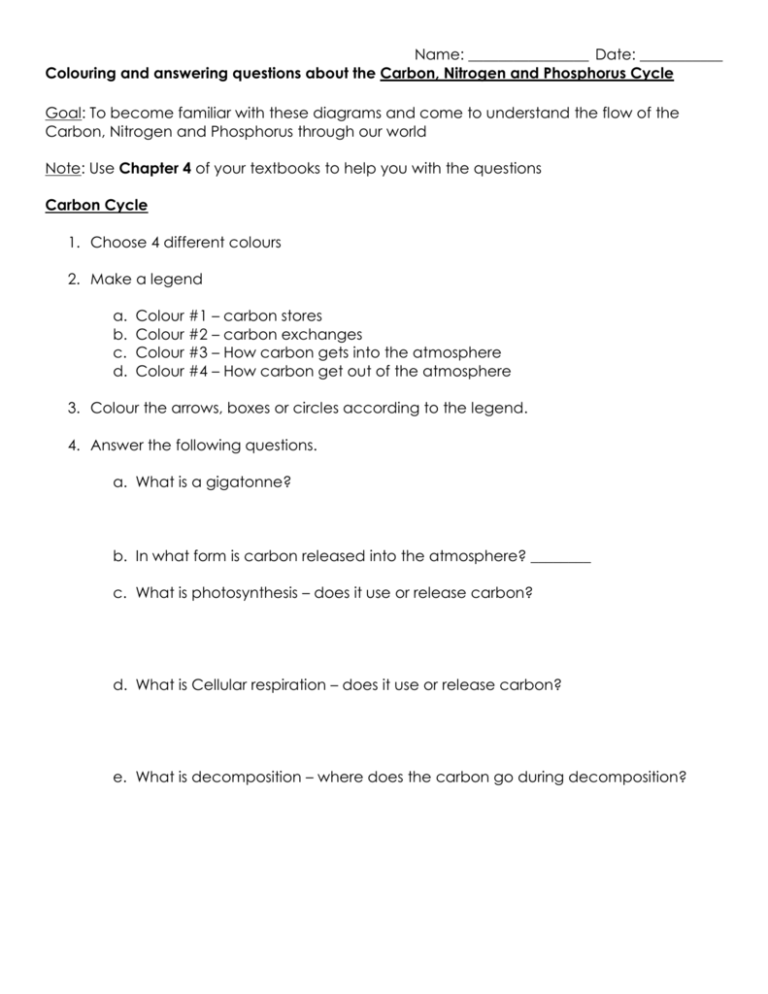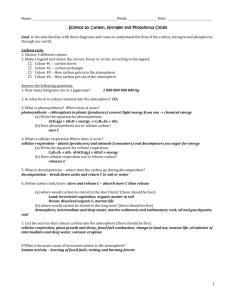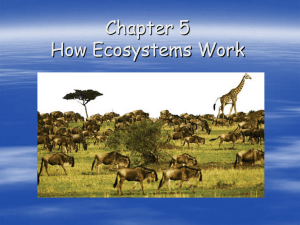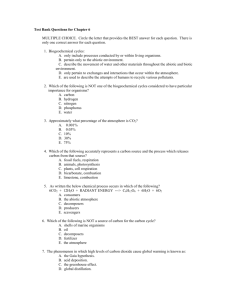3 Cycles
advertisement

Name: ________________ Date: ___________ Colouring and answering questions about the Carbon, Nitrogen and Phosphorus Cycle Goal: To become familiar with these diagrams and come to understand the flow of the Carbon, Nitrogen and Phosphorus through our world Note: Use Chapter 4 of your textbooks to help you with the questions Carbon Cycle 1. Choose 4 different colours 2. Make a legend a. b. c. d. Colour #1 – carbon stores Colour #2 – carbon exchanges Colour #3 – How carbon gets into the atmosphere Colour #4 – How carbon get out of the atmosphere 3. Colour the arrows, boxes or circles according to the legend. 4. Answer the following questions. a. What is a gigatonne? b. In what form is carbon released into the atmosphere? ________ c. What is photosynthesis – does it use or release carbon? d. What is Cellular respiration – does it use or release carbon? e. What is decomposition – where does the carbon go during decomposition? Name: ________________ Date: ___________ f. List the carbon sinks/stores (there should be 9). a) b) c) d) e) f) g) h) i) g. List the sources that release carbon into the atmosphere (there should be 5). 1) 2) 3) 4) 5) h. What is the main cause of increased carbon in the atmosphere? i. How will the change in carbon affect the planet in the near future? Name: ________________ Date: ___________ Nitrogen Cycle 1. Choose 4 different colours 2. Make a legend a. b. c. d. Colour #1 – How nitrogen gets into the soil Colour #2 – How nitrogen gets into the plants Colour #3 – How nitrogen gets into the water Colour #4 – How nitrogen gets into the air 3. Colour the arrows according to the legend 4. Answer the following questions. a. List the 8 chemicals that contain nitrogen (include their name and formula): a) b) c) d) e) f) g) h) b. What is nitrogen fixation? Give an example of how it occurs. Nitrogen Fixation: Example: c. What is denitrification? Give an example of how it occurs. Denitrification: Example: d. What is nitrification? Give an example of how it occurs. Nitrification: Example: Name: ________________ Date: ___________ e. What do nitrogen fixing bacteria do? (In other words what reaction do they help with?) f. What two reactions do nitrifying bacteria help with? 1) 2) g. List the three ways in which nitrogen gets into the atmosphere. 1) 2) 3) h. List four ways in which nitrogen gets into the soil. 1) 2) 3) 4) i. List three ways in which nitrogen gets into water. 1) 2) 3) j. List two sources of nitrogen that plants can use. 1) 2) k. How does nitrogen get into the bodies of animals? Name: ________________ Date: ___________ Phosphorus Cycle 1. Choose 6 different colours 2. Make a legend a. b. c. d. e. f. Colour #1 – Phosphorus flows Colour #2 – Phosphorus stores Colour #3 – Long cycle - How phosphorus moves from ocean sediments to soil Colour #4 – Short cycle – How phosphorus moves through a land ecosystem Colour #5 – Short cycle – How phosphorus moves through an aquatic ecosystem Colour #6 – Short cycles – How phosphorus moves between the land and water ecosystems 3. Colour the arrows according to the legend 4. Answer the following questions. a. What are the phosphorus sinks/stores (there should be five)? Which one is the greatest? 1) 2) 3) 4) 5) b. What are the main sources of phosphorus (there should be 8)? Which one is the greatest? a) b) c) d) e) f) g) h) Name: ________________ Date: ___________ c. The main chemical that contains phosphorus that we need to worry about? _______________ How is this chemical produced? – __________________ d. There are three short cycles on the diagram – one on land, one in the water and one in water/land and air – describe them. What is the source of the phosphorus in each case? Land: Water: Water/land and air: e. The long cycle ties into the three short cycles – it is due to geologic uplift. How is the long cycle different from the short cycles? Name: ________________ Date: ___________ Name: ________________ Date: ___________ Name: ________________ Date: ___________ Name: ________________ Date: ___________








